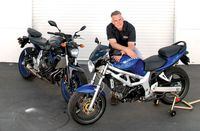Sixteen years ago, Suzuki delivered upon us the SV650, a machine some believed cribbed a little too liberally from the Ducati playbook. In our first road test, the late Greg McQuide described the SV pulling away from a much more powerful TL1000 up a mountain road and posed the question: "Whether or not this is enough to satisfy the US market's tastes, however, is a question that remains to be answered."
At a time when horsepower was king, we openly wondered if a balanced, modestly quick sporting naked would succeed. Its 68 rear-wheel horsepower was well up on the previous class sweetheart, Honda’s Hawk GT, but still trailed Suzuki’s own Bandit 600 by a quintet of ponies. At $5,699, it was inexpensive but not cheap. Nothing from the outside, not even the pretty aluminum frame with cast and extruded pieces, gave voice to the rambunctious toy the SV really was.
Sales? We didn’t have to wonder long. The SV moved very briskly from the start. Experienced riders embraced the SV’s quick but not overly sharp handling, the lovely cadence of the 645cc, 90-degree V-twin, and the sense of confidence this tidy little motorcycle provided. But most important was that the SV transcended ranking. Old hands were flocking to the bike at the same time new and returning riders were lapping it up as an alternative to the quarter-liter machines or the four-cylinder supersports on the menu. And they were better for it, since the SV balances performance and forgiveness brilliantly.
For almost a decade, until the unfortunate transition into the misguided SFV650 (nee Gladius), the SV650 was a touchstone, the bike I’d recommend to just about anyone. Post Gladius, I counseled finding a good used SV.
Now I don't have to. Yamaha, on a pretty hellacious tear with innovative and affordable new product, now has the FZ-07. Adjusted for inflation, the SV's introductory price is $8,100 in 2014 dollars, making the FZ's $6,990 MSRP seem even better. It's not just that the Fizz is a good value; it's also a rollicking good motorcycle, a true and worthy successor to the SV. How good? To find out, I took an afternoon and rode my near-stock 2000 SV650 naked back to back with the FZ-07.
What you’d think would be most different actually was not. Yamaha’s 689cc parallel twin uses a 270-degree crank arrangement and balance shafts to provide an interesting aural and vibratory signature—it’s unique like a V-twin but has its own feel. If anything, the Yamaha has stronger midrange along with much snappier throttle response than my carbureted SV offers. The SV’s engine still feels good, but the FZ’s is sharper, tighter, and a bit more modern.
A development gap of 16 years shows up in the chassis, most notably the size of the machines. The FZ feels tiny, super agile, but still stable enough for beginners—plus the seat is low and narrow, and the reach to the bar is minimal, almost too tight for me. By comparison, the SV feels about 115-percent scale, which makes its similarly soft suspension seem ever more so, and amplifies the inherent crumminess of the stock brakes. Back in the day, we didn’t complain much about the SV, but the FZ’s binders, while still not world class, are a good generation ahead of the Suzuki’s.
More than anything, though, these bikes reinforce the brilliance of the type—a compact (but not too small), modestly powered (but not under-powered), competent midsize sporty bike that doesn’t ask too much and always over delivers. Inherent, true balance without affectation. I’m sorry that Suzuki doesn’t make the SV any longer, but I’m more than happy that Yamaha will.











/cloudfront-us-east-1.images.arcpublishing.com/octane/7GJYDUIPXRGMTMQKN6ONYOLBOU.jpg)
/cloudfront-us-east-1.images.arcpublishing.com/octane/MUQLOVLL2ZDGFH25ILABNBXKTI.jpg)
/cloudfront-us-east-1.images.arcpublishing.com/octane/TNOU5DNE2BC57MFPMGN2EIDXAM.jpg)
/cloudfront-us-east-1.images.arcpublishing.com/octane/GTCXACQGJ5HAPDTGWUQKDEH44E.jpg)
/cloudfront-us-east-1.images.arcpublishing.com/octane/S35YGSEMEZB4BLTDJTSZPF4GLA.jpg)
/cloudfront-us-east-1.images.arcpublishing.com/octane/5UOT6HPX2JFMRJAX6EH45AR4MQ.jpg)
/cloudfront-us-east-1.images.arcpublishing.com/octane/OKWOJWAKP5EP3OACCRRWPCIX2Q.jpg)
/cloudfront-us-east-1.images.arcpublishing.com/octane/2WF3SCE3NFBQXLDNJM7KMXA45E.jpg)
/cloudfront-us-east-1.images.arcpublishing.com/octane/G4MG6OUCJNBSHIS2MVVOTPX65E.jpg)
/cloudfront-us-east-1.images.arcpublishing.com/octane/IIGGWFOTOJGB7DB6DGBXCCMTDY.jpg)
/cloudfront-us-east-1.images.arcpublishing.com/octane/QSTCM6AVEZA5JJBUXNIQ3DSOF4.jpg)
/cloudfront-us-east-1.images.arcpublishing.com/octane/U4I7G625B5DMLF2DVIJDFZVV6M.jpg)
/cloudfront-us-east-1.images.arcpublishing.com/octane/B6XD6LS6IVCQPIU6HXDJSM3FHY.jpg)
/cloudfront-us-east-1.images.arcpublishing.com/octane/ICL63FEDDRDTTMINYICCEYGMDA.jpg)
/cloudfront-us-east-1.images.arcpublishing.com/octane/FCGZHQXRBZFLBAPC5SDIQLVF4I.jpg)
/cloudfront-us-east-1.images.arcpublishing.com/octane/WNOB6LDOIFFHJKPSVIWDYUGOPM.jpg)

/cloudfront-us-east-1.images.arcpublishing.com/octane/X33NU3E525ECRHXLNUJN2FTRKI.jpg)
/cloudfront-us-east-1.images.arcpublishing.com/octane/6KKT5NNL2JAVBOXMZYS5ZO76YA.jpg)
/cloudfront-us-east-1.images.arcpublishing.com/octane/J5RKG5O455GMPGQRF2OG6LRT7A.jpg)
/cloudfront-us-east-1.images.arcpublishing.com/octane/GX2CIZKQVRH2TATDM26KFG2DAE.jpg)
/cloudfront-us-east-1.images.arcpublishing.com/octane/ZWIDYSAKQZHD5BHREMQILXJCGM.jpg)
/cloudfront-us-east-1.images.arcpublishing.com/octane/CYUHJZCTSJCH3MRAQEIKXK7SCQ.jpg)
/cloudfront-us-east-1.images.arcpublishing.com/octane/LKOFINY56FCXJCANJ5M7ZDQUBY.jpg)